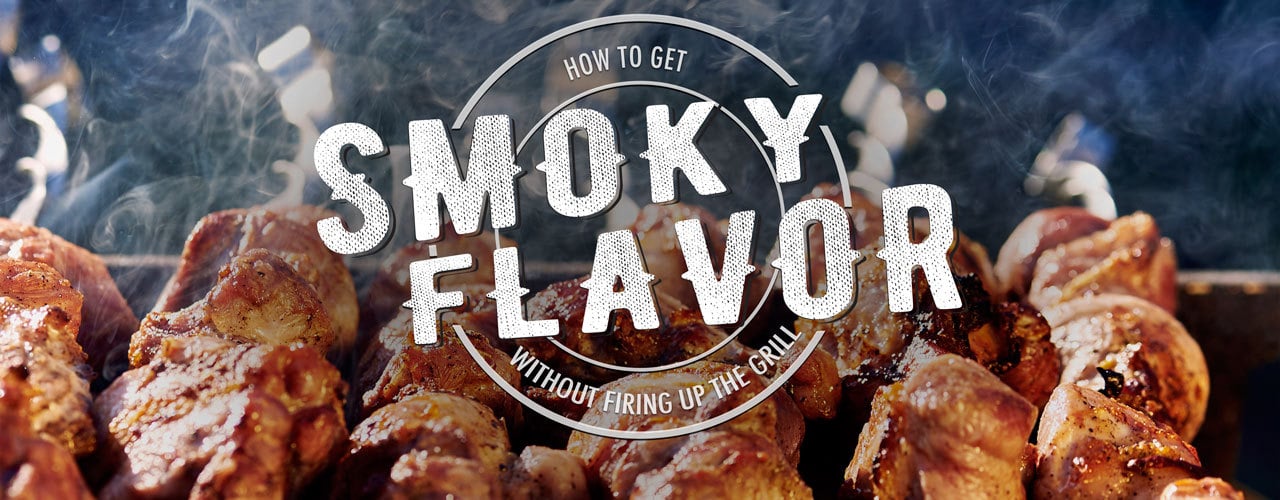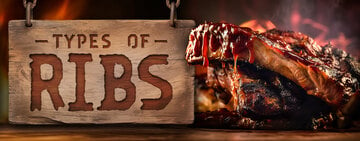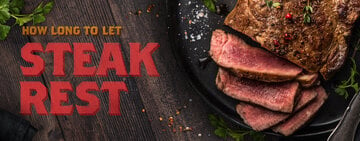Smoky Ingredients
Last updated on Oct 14, 2024Corrinn McCauleyWhat distinguishes American BBQ from Argentinian BBQ and other barbecuing traditions is its rich, smoky flavor. Whether you want to enhance the meat smoking process by adding smoky ingredients to your spice rubs or create a smoky flavor without firing up a grill, we guide you through the best smoky ingredients. You’re just a few pantry items away from offering a summertime grill menu year-round.
Smoke Flavor Ingredients
From global spices to gourmet grocery items, discover ingredients that add smoke flavor. Depending on your menu, kitchen, and staff, you’ll require varying smoky flavor profiles and applications. We provide a list of ingredients that add smoke flavor and the best uses for each.
1. Liquid Smoke

Liquid smoke is a naturally occurring substance made from real smoke. By burning wood pellets and condensing the smoke, manufacturers capture it as a liquid. Once it has been distilled and filtered, liquid smoke is one of the simplest ways to add pure smoke flavor to your foods.
How to Use Liquid Smoke
Discover the best ways to use liquid smoke below:
- Marinades
- Sauce ingredient
- Rubs
- Flavoring agent in soft cheeses, bacon, and tofu
2. Smoked Salt

Smoked salt is sea salt flakes infused with smoke from real, untreated wood for up to 14 days. Popular woods for smoking salts include applewood, mesquite, alder, oak, and hickory. The wood used will determine the flavor profile. Mesquite and applewood smoked salts have a sweet essence, whereas alderwood and hickory smoked salts have a more robust flavor. You can purchase smoked salt from a foodservice wholesaler, or you can smoke it yourself.
How to Use Smoked Salt
Smoked salt shines when you use it as a finishing touch. When you cook with smoked salt, its flavor is lost. Popular uses for smoked salt include:
- Corn on the cob
- Fish
- Vegetable roasts
- Chicken
- Sprinkled on desserts
- Steak
- Rimming cocktail glasses
3. Smoked Paprika
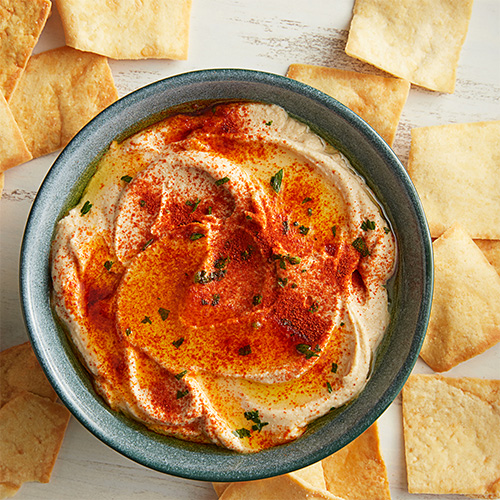
Smoked paprika is made from pimenton peppers that are slowly smoked over oak. Pimenton peppers come from the southwestern La Vera region of Spain, and smoked paprika is a staple in Spanish cuisine. It is a fantastic way to imbue foods with a smoky, woodsy flavor without smoking them.
How to Use Smoked Paprika
Full of umami flavor, smoked paprika pairs best with savory ingredients like meats and vegetables. Its rich hue enhances the visual appeal of pale foods like potatoes and chicken. Popular uses for smoked paprika include:
- Memphis-style dry rub
- Paella
- Chorizo sausage
- Potatoes
- Vegetable roasts
4. Lapsang Souchong

Lapsang souchong is a type of oxidized black tea that features a sweet yet smoky flavor. Once the tea leaves are picked, they are placed over a fire to eliminate moisture. During this step, the leaves are infused with a smoke flavor. It was first created in 1646 during the Qing dynasty by citizens of the Wuyi Mountains looking to prevent freshly picked tea leaves from spoiling. Today, the tea is often used to flavor vegetarian dishes and is said to give meaty, umami richness to foods without using meat.
How to Use Lapsang Souchong
To cook with lapsang souchong, use a spice grinder to grind it into a fine powder. You’ll typically only use about 1 teaspoon at a time. The lapsang souchong powder will remain unspoiled for three months. While drinking lapsang souchong as tea is its first intended use, it’s also a great smoky ingredient in:
- Vegan menu items
- Cocktails
- Rubs
- Soups
- Hummus
- Baba ghanoush
5. Chipotle Powder

Chipotle powder contains one ingredient: smoked, dried jalapeno peppers that have been crushed into a powdered form. The spiciness of the peppers paired with the smoke make chipotle powder a great way to add savory flavor to various dishes.
How to Use Chipotle Powder
Chipotle powder is a common spice in traditional Hispanic cuisine, Tex-Mex dishes, and Southwestern cooking. Popular ways to use chipotle powder include:
- Burritos
- Tacos
- Meat rubs
- Chili
- Beans
6. Black Cardamom
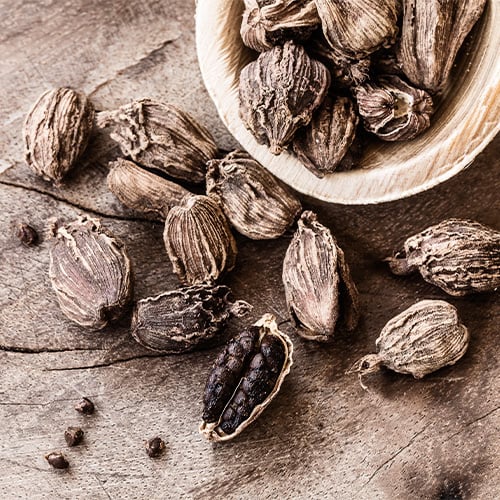
In its natural state, black cardamom is a tough, wrinkly seed pod that contains tiny, sticky, dark seeds that have a citrus and eucalyptus flavor. Spice producers make black cardamom by fire-drying the seed pods, which saturates them with a deep, smoky flavor. Once dried, the citrus and eucalyptus essences turn to a minty aroma, which complements the smoke. It is considered a warming spice and is categorized alongside black pepper, cloves, and chilis. There are two main types of black cardamom: amomum subulatum and amomum tsao-ko. Amomum subulatum is a staple in Indian cuisine, and amomum tsao-ko is a key ingredient in many Chinese recipes.
How to Use Black Cardamom
While it will effectively add smoke flavor to any dish, black cardamom is the third most expensive spice, so you should only use it over other smoky ingredients when it will make or break the dish. We provide the best uses for both types of black cardamom below.
- Curries - amomum subulatum
- Daals (lentil dishes) - amomum subulatum
- Pilafs - amomum subulatum
- Pho Soup - amomum tsao-ko
- Jin-jin Braised Meat Dishes - amomum tsao-ko
- Sichuan Dishes - amomum tsao-ko
7. Smoked Bacon
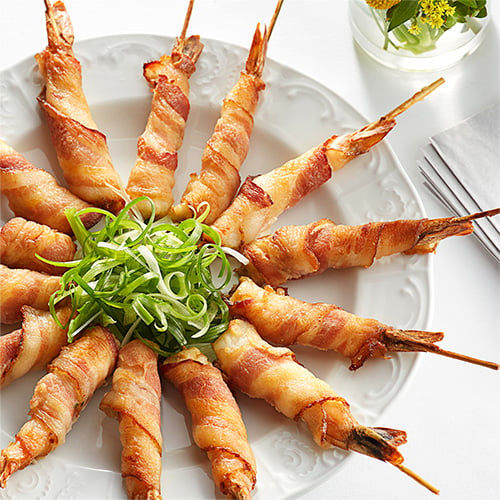
Bacon comes in many different styles and can be used in various recipes. When smoked bacon is used as an ingredient, it transfers some of its flavors to the dish. However, it's important to note that bacon can't be added to every recipe. Take the time to analyze your menu and identify different dishes that might be improved by adding smoked bacon to them.
How to Use Smoked Bacon
The most effective way to use smoked bacon to add smoke flavor is to first chop the bacon into pieces and render out the fat. Use the rendered bacon fat to cook the rest of your ingredients (which coats them all in the smoky bacon flavor) before adding the bacon pieces back into your recipe. The best ways to add smoke flavor using bacon include:
- Sauteed Vegetables
- Soups
- Creole Jambalaya
- Bacon-wrapped meats and vegetables
8. Black Strap Molasses

A byproduct of the sugar-making process, molasses is typically used to add sweetness or texture to a dish. One type of molasses, known as blackstrap molasses, allows you to add a hint of smokiness to your menu. Blackstrap molasses features a bittersweet flavor and is a healthier alternative to traditional molasses. It offers vitamins and minerals such as calcium, magnesium, and iron, and is rich in antioxidants. Can't access molasses? Try some of these molasses substitutes.
How to Use Black Strap Molasses
Though molasses is often thought of as a baking ingredient, blackstrap molasses is commonly used to flavor many savory dishes. Popular uses for blackstrap molasses include:
- BBQ Sauce
- Vegan Bacon
- Baked beans
- Salad dressing
9. Smoked Olive Oil
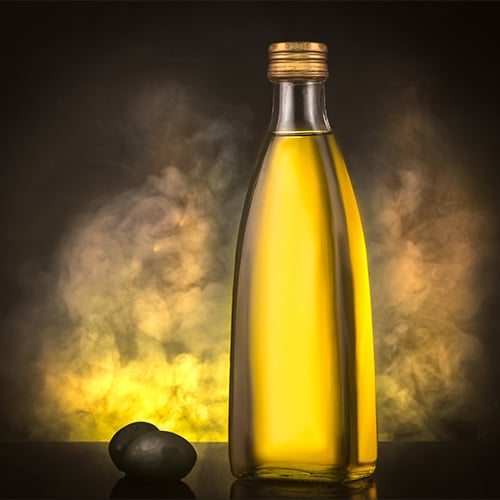
Smoked olive oil is a type of premium olive oil that has been cold smoked, imbuing it with a rich smoke flavor. It’s a healthy alternative to using rendered smoked bacon fat to imbue foods with smoky flavors. This gourmet grocery item is for the creative chef who wants to add smoky flavors while also increasing the nutritional value and texture of their dish.
How to Use Smoked Olive Oil
The best uses for your smoked olive oil will depend on its smoke point. Light refined olive oil has a smoke point between 390 and 479 degrees Fahrenheit, making it ideal for high-heat cooking applications. Extra virgin olive oil has a smoke point of 320 degrees Fahrenheit and should only be used as a finishing or salad oil or for low-heat cooking applications.
- Vegetable roasts
- Salad dressings
- Bread dips
- Marinades
- Sauteing
Even if it’s too cold outside to use your grill or smoker, that doesn’t mean you can’t create meals with a smoky flavor. The next time you want to add smoke flavor, reference back to our list of smoky ingredients to help you write your recipe. With so many options, the temperature outside doesn't need to limit the wood-fired flavors you offer your customers.
